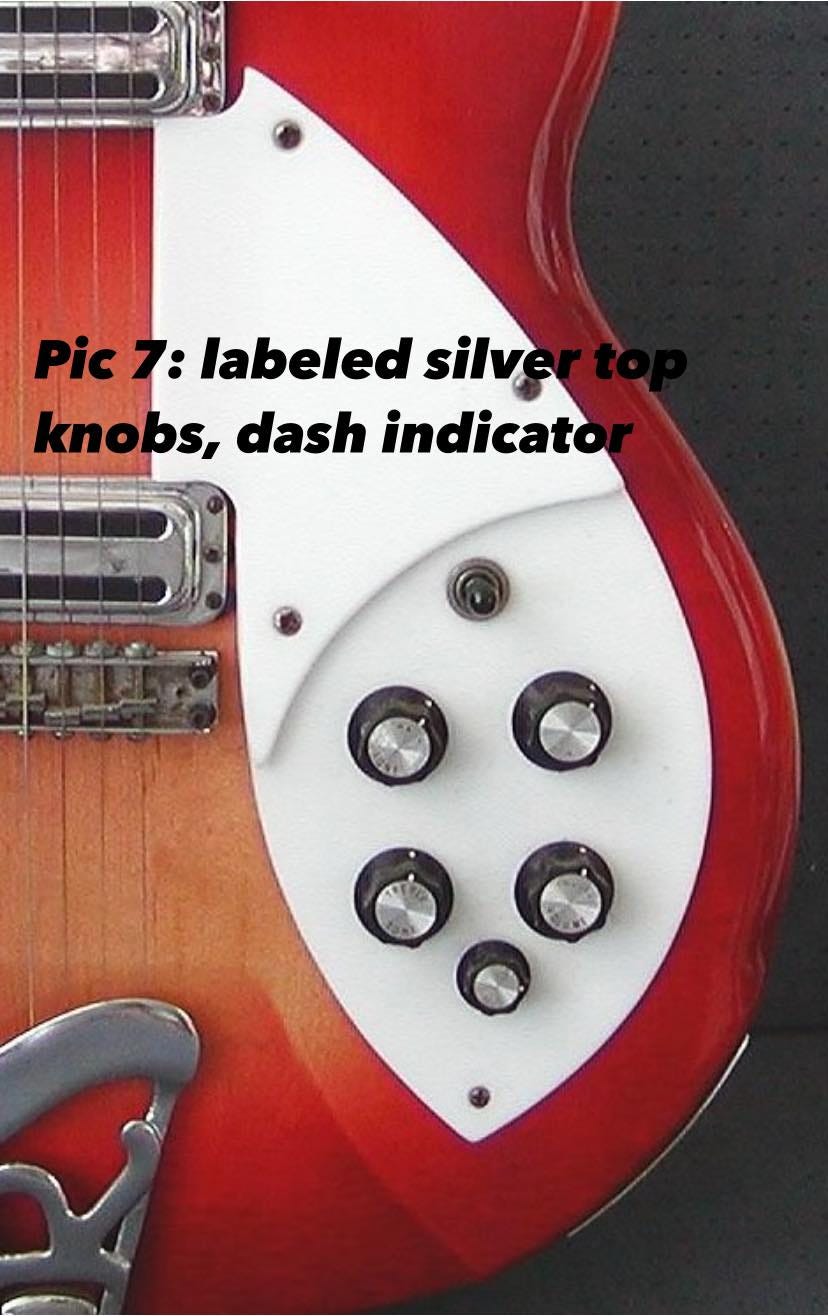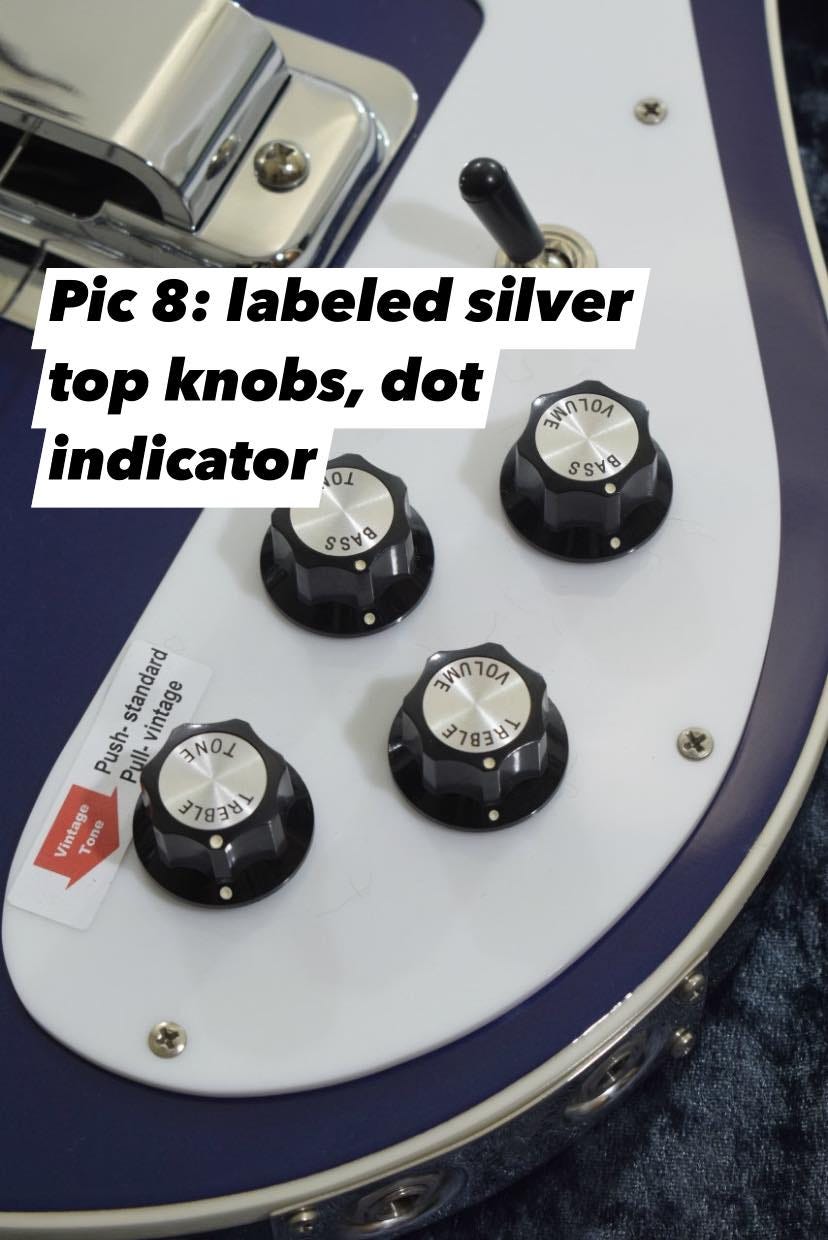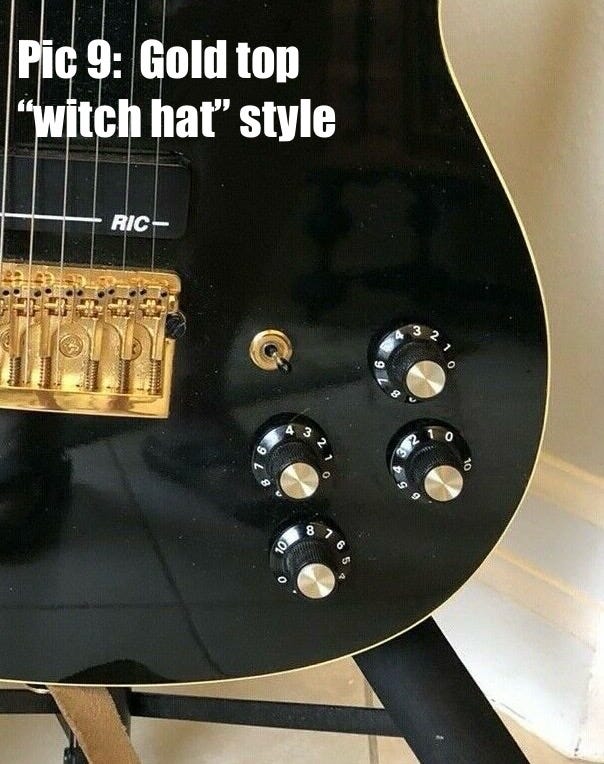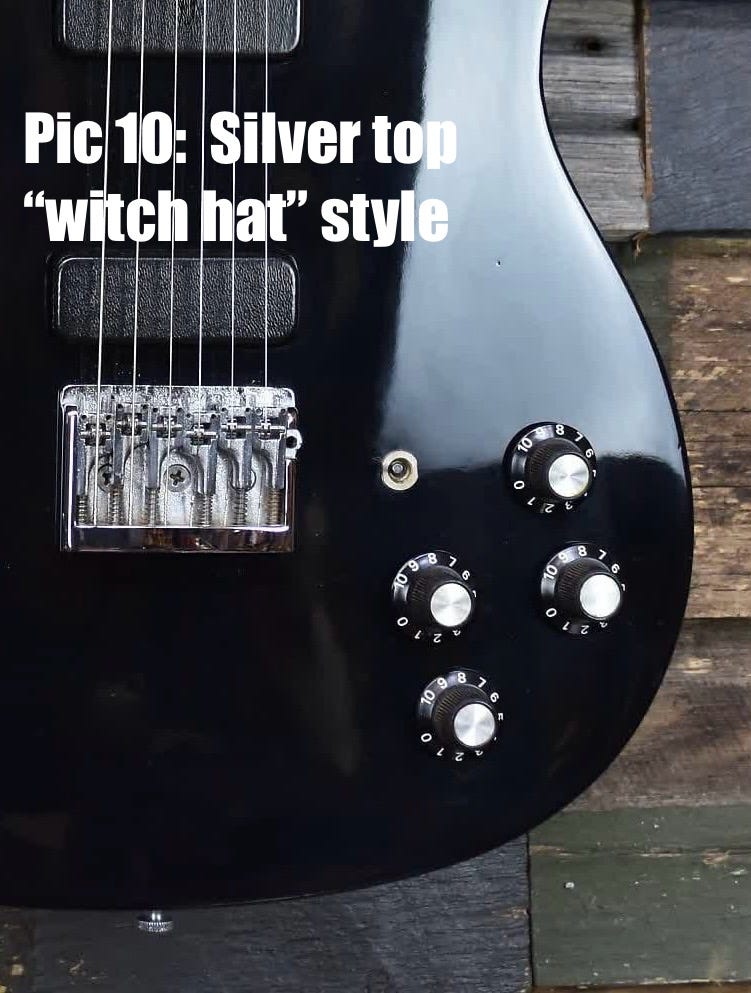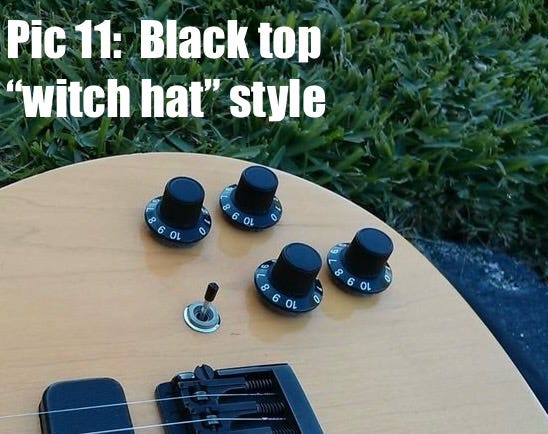Deep Dive: Knobs
First, a major caveat. Knobs are just about the easiest part of a guitar to change. So when looking at modern pictures of older guitars—especially in places like the Register, but even in reliable sources like Martin Kelly’s book—we have to make some assumptions as to whether the knobs on the guitar are original or not. As much as possible, I have crosschecked contemporary photos against period materials to validate. But I promise you I’ve gotten something wrong. Tell me about it, and I’ll correct it and give credit. Also, we’re gonna skip steel guitars and the 1930’s Electric Spanish guitars here. That’s not really our thing, right? I mean, lots of us may have one (or several!), but we’re gonna focus on the modern electric guitars that first appeared in 1954. OK?
So, on those first “modern” Rickenbacker guitars, the Combo 600 and 800, I can find both current and contemporary examples of three types of knobs used. The far most common are the chromed dome top/ribbed side knobs (labeled Pic #1 below) as found on contemporary console steels.
Makes sense—waste not, want not, right?
That appears to be the “production” knob used from launch in 1954 through the end of production of these models. As other models began to appear over the next few years, the same knob appeared on many of them: the Combo 650/850, the 4000 bass, and the first short scale Capris—but we’ll talk more about those in a minute. So that’s knob number one.
Seen on at least one (and maybe two, hard to say) guitars in period materials are the clear knobs in Pic #2.
Ron O'Keefe can tell us more, but they look to me like clear lucite “speed knobs”. I believe they were for show guitars and not general production.
And finally we have black bakelite “UFO” knobs as seen in Pic #3—more common than the clear ones above, but far less common than the chrome ones.
These knobs appear to be the same type as fitted to lap steels of the period—which makes sense—but it is very hard to tell exactly what types they are in period photos and there are multiple types found in current photos. The one pictured is the most common, so I’m going to go with that. Note that knob types 2 (clear lucite) and 3 (bakelite lap steel) ONLY appear on combo 600 and 800’s.
The next knob to show up chronologically is one we all know and love today: the black KK “vintage” knob with its skirt with indicator dot, fluted sides, and white indicator line on its domed top (Pic #4).
These first appeared on the Combo 400 in 1956, followed by the Combo 450, the short scale solidbody 900/950/1000s, and then cresting wave 400/600s. It made a leap to semi-hollowbody guitars in 1964, but we’ll get there in a minute. It became THE knob of the early 60’s, but its history gets complicated after that so we’ll come back to it a little later.
Next we have to talk about the Capri models. As already stated, the prototype/very first short scale Capris had the chrome dome top/knurled side knobs discussed above. Those were quickly replaced by the now famous Rogan “cooker” knob (pic #5)— brown phenolic knobs with a diamond-shaped grip, large skirts, a small notched indicator, and gold brushed metal inserts.
These knobs look similar to ones used on many period kitchen appliances, which is how they picked up the “cooker knob” or “TV knob” nicknames. These knobs appeared on all full scale Capri models, including the “new Capri” through 1963. They also appeared on the first generation F series 330/360 guitars produced during this time. To the best of my knowledge, these knobs never appeared on a solidbody guitar (OK, the 4003S/AC. I meant IN PERIOD), and with the exception of those first prototype/very early production short scale Capris, ALL semi-hollow bodies guitars made before 1964 featured these knobs (and for the pedants out there, YES the Combo 600/800 can technically be called semi-hollowbodies, but c’mon. It’s weight relieved).
In 1964 the Capri models—short and long scale both—changed their gold plastics to white, and discontinued the use of Rogan knobs. Knobs on all semi-hollow guitars were replaced with the same black “vintage” knobs already in use on the solidbody guitars. So for MOST of 1964, the vintage black knob was the only knob in use. That would change late in the year with the introduction of the “New Style” carved top/rounded horn 360.
Before we discuss that, we should go back quickly to knob number one, the chrome console steel knobs. The last use of those knobs was on the 1961 4000/4001 basses. When the redesigned basses appeared in 1963, they too featured the black vintage knobs.
The new round top 360 had brand new knobs: the skirted, fluted side, silver top knobs that would go on to be the primary knob used on most guitars for the next 56 years. But there are a couple of variations on this knob. The very first knobs (Pic #6) had no labels on the top, a white indicator dot on the skirt, and a white indicator dash on the top.
Around July of 1965, the knobs gained the familiar “Bass/Treble Tone/Volume” labels, but would maintain the white skirt indicator dot and white top indicator dash (Pic #7).
In late 1966 the white top indicator dash would transition to a white dot (Pic #8), although you will find guitars with mismatched dot/dash tops well into 1967. This would be the final iteration of the silver top knob, which would serve as the primary knob on all non-“reissue” guitars until they were discontinued in 2020.
The silver top knob began moving to guitars other than the 360 (and all its iterations) around July of 1965. By the end of that year, with a couple key exceptions we’ll discuss here, the transition was complete. The first holdouts were the two knob/one pickup guitars like the 420/425 and the short scale 900/1000s where the “Bass/Treble” labels on the knobs didn’t make sense. The shorties ended production in the late 1960s and would never gain silver knobs—with one key exception. A small run in the 1980s of ES16 guitars used unlabeled silver top knobs—which had ended up being the solution for the 420/425 and the later two knob 4000, which seem to have made the switch from black to silver top somewhere around 1974. While you can always find exceptions to the rules in what I have laid out above, the important thing to remember is that by 1974 the black vintage knob was no more and the silver top knob was on everything. And that’s how it stayed until the V series guitars appeared in 1985.
The V Series guitars reintroduced the black “vintage” and the Rogan “cooker” knobs. For the most part, the V/C Series guitars use the correct knob for the guitar they are emulating, with the notable exception of 381V69’s made since 2020. What’s wrong there and why? Well, the original 381—being introduced in 1969—had silver top knobs. But in 2020, due (probably) to Covid-related supply chain disruptions, Rickenbacker ran out of silver top knobs. So they started throwing the black vintage knobs on everything—including the 381V69. And at some point, they (probably) said “heck it’s cheaper and easier to only have one knob, so now we only have one knob,” and the silver top knob disappeared after a 56 year run.
So those are the “main” knobs you’ll find on production guitars. Well, perhaps I should say “core” production guitars. Many models/product lines have come and gone over the years, and a coupleof them had their very own knobs. So let’s have a look at those now!
First things first: any oddballs that popped up in the 1960s-1970s wore whatever was the “standard-for-the-time”. Bantars and Banjolines? Labeled silver tops. The bastard child of a Rickenbacker and a Telecaster 430 that appeared in 1975? Ditto. The contemporary 3000-series basses also came with silver tops—albeit unlabeled. The “rare as hen’s teeth” 4002 bass came with bog standard labeled silver tops. It wasn’t until the 1980’s that things started to get interesting.
The 200 series guitars and 2000 series basses appeared in 1984 and brought the first “new” knob since the silver tops: unlabeled knobs somewhat similar to the “witch hat” knobs found on Fender amps or Gibson guitars—black with numbers printed on the skirt, but with knurled barrels that were more cylindrical than the conical witch hat knob. These came with a gold (for the 250 and 2050) or silver (for the 230 and 2030) top (Pic #9 and #10).
But these knobs did not last long at all. Beginning in mid 1985 both the silver and gold topped versions were replaced by a similar knob with a plain black top (Pic #11).
The next new knob would appear in 1992 with the introduction of the 650 series of guitars and the 4004 bass. The “Standard” 650 Atlantis/Colorado/Dakota and 4004 Laredo received flat topped chrome knobs with knurled edges and an indented indicator dot on top (Pic #12), and the “Deluxe” 650 Sierra/Excalibur/Frisco and 4004 Cheyenne got similar knobs in gold (Pic #13).
That same year the 200/2000 series got updated, with the new “Standard” 220 and 2020 getting the chrome version of this knob and the “Deluxe” 260 and 2060 receiving the gold version. While the these knobs have appeared on various one-offs over the years, 2017 was the end of the line for them as “stock” when the last production 4004s were produced.
And that, I think, is all there is to know or say about knobs. If I got anything wrong, please let me know and I’ll fix it!








